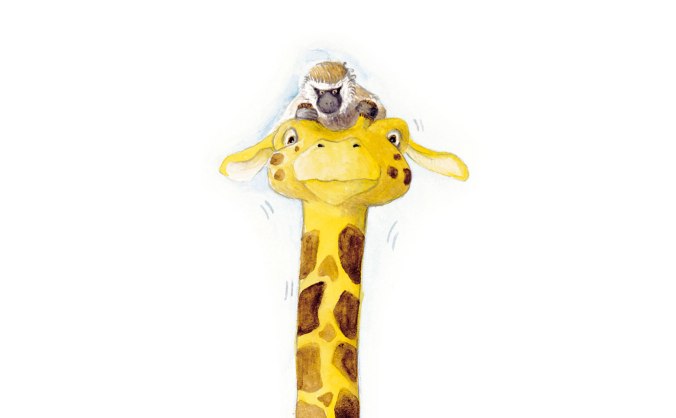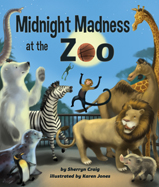
Did you know that giraffes, often a very quiet animal, hum in their sleep late at night? Zookeepers involved in the study were even surprised that researchers picked up a low humming noise from their giraffes.
Researchers spent hundreds of hours recording sounds in the giraffe’s enclosures and in each zoo at least one giraffe was separated from the herd.
Although the sound recordings tell us that giraffes do have more vocalization than the grunts and sneezes that keepers hear during the day, now scientists may go further to understand if this is a communication method or if it is involuntary like snoring or talking in your sleep.
Hear the giraffe’s hum and learn more about the study here.
Do you want to learn more about giraffes, or animal sounds? Here are two Arbordale books that would be a great start on the topic!
The Giraffe Who was Afraid of Heights
 Imagine if the one thing that keeps you safe is what you fear the most. This enchanting story tells of a giraffe who suffers from the fear of heights. His parents worry about his safety and send him to the village doctor for treatment. Along the way he befriends a monkey who is afraid of climbing trees and a hippo who is afraid of water. A life-threatening event causes the three friends to face and overcome each of their fears. The “For Creative Minds” section includes fun facts and animal adaptation information, a match-the-feet game and a mix-n-match activity.
Imagine if the one thing that keeps you safe is what you fear the most. This enchanting story tells of a giraffe who suffers from the fear of heights. His parents worry about his safety and send him to the village doctor for treatment. Along the way he befriends a monkey who is afraid of climbing trees and a hippo who is afraid of water. A life-threatening event causes the three friends to face and overcome each of their fears. The “For Creative Minds” section includes fun facts and animal adaptation information, a match-the-feet game and a mix-n-match activity.
Sounds of the Savanna
 From the first light of dawn until the sun sets at night, the savanna is alive with noise. A lion roars in the early morning, a young baboon shrieks to warn others of danger at noon, and a young mouse squeals at dusk. What are the animals saying and why? Animals communicate in many ways; explore the thriving African savanna as its inhabitants “talk” to one another throughout the course of a day.
From the first light of dawn until the sun sets at night, the savanna is alive with noise. A lion roars in the early morning, a young baboon shrieks to warn others of danger at noon, and a young mouse squeals at dusk. What are the animals saying and why? Animals communicate in many ways; explore the thriving African savanna as its inhabitants “talk” to one another throughout the course of a day.
And…Look forward to next year when we see what really happens at night in the zoo! Midnight Madness at the Zoo coming February 2016!



 Terry Catasús Jennings has a talent for taking a simple concept and telling a great story. In her newest book Sounds of the Savanna, Terry takes readers to the African plains and shows them how important sound is to the animals that live in this habitat.
Terry Catasús Jennings has a talent for taking a simple concept and telling a great story. In her newest book Sounds of the Savanna, Terry takes readers to the African plains and shows them how important sound is to the animals that live in this habitat.
Get to know a little more about Terry’s writing:
 How did you first become interested in writing, and writing for children’s picture books?
How did you first become interested in writing, and writing for children’s picture books?
When I read Little Women by Louisa May Alcott as a very young girl, I knew I wanted to be a writer, just like Jo March. I believe though, that I would have ended up being a writer even if I hadn’t read the book. Stories are always rolling around in my head. Whenever something happens I like to report on it, like writing a newspaper story, in my head. I also like to figure out why people may have acted in a particular way, so I take what happens and I figure out a plot line that may have led them to their actions. Sounds crazy, doesn’t it? What I like best of all is figuring out the very best way to convey each message—the best words to use, how to form each sentence and that is especially important in a picture book. I love to use the rhythm of language when I write a picture book. It’s almost like writing a poem.
Do you have any tips for aspiring writers?
Read, read, read. Write, write, write. Look at the world with curiosity and try to figure out why things happen they way they do and why people act the way they do. Listen to people talk. Pay special attention to how they move. Capture a scene as if you were a movie camera and store it in your mind. You’ll use all those things that you have stored in your mind when you write your books.
You can read the full interview here!
But first here is a great roaring lion craft to go along with the book’s For Creative Minds section, check it out.
 What you will need:
What you will need:
- You can use felt or paper (for our mask we used paper).
- You will need light brown, dark brown or black, A shade of red/pink, and white.
- Scissors and a pencil
- A large circle and small circular container for tracing
- A stick, for ours we used a pipe cleaner
- On tan paper use the large circle and trace three circles in a heart shape pattern. Connect the two top circles to the bottom and cut out your back portion.
- On the same paper trace two circles connect them together at the top to form a straight line and cut those out. For the nose of your lion.
- On the dark brown or black paper use the smaller circle and repeat step one. This will form your open mouth.
- Again on the dark paper cut a triangle for the nose and then round the edges
- On the pink paper use the bottom of the open mouth form and trace the lower portion of the tongue. Use your small circle to overlap and form the heart shape of the top of the tongue.
- On white paper cut two narrow triangles.
- Glue the dark mouth to the background, glue the tongue in place and then the teeth. Glue the triangle nose onto the tan nose, then glue that on top of your lion mouth.
- Tape or glue a stick to the back and you have your finished roaring lion!
Leave a comment and enter to win a copy of Sounds of the Savanna!


 Imagine if the one thing that keeps you safe is what you fear the most. This enchanting story tells of a giraffe who suffers from the fear of heights. His parents worry about his safety and send him to the village doctor for treatment. Along the way he befriends a monkey who is afraid of climbing trees and a hippo who is afraid of water. A life-threatening event causes the three friends to face and overcome each of their fears. The “For Creative Minds” section includes fun facts and animal adaptation information, a match-the-feet game and a mix-n-match activity.
Imagine if the one thing that keeps you safe is what you fear the most. This enchanting story tells of a giraffe who suffers from the fear of heights. His parents worry about his safety and send him to the village doctor for treatment. Along the way he befriends a monkey who is afraid of climbing trees and a hippo who is afraid of water. A life-threatening event causes the three friends to face and overcome each of their fears. The “For Creative Minds” section includes fun facts and animal adaptation information, a match-the-feet game and a mix-n-match activity. From the first light of dawn until the sun sets at night, the savanna is alive with noise. A lion roars in the early morning, a young baboon shrieks to warn others of danger at noon, and a young mouse squeals at dusk. What are the animals saying and why? Animals communicate in many ways; explore the thriving African savanna as its inhabitants “talk” to one another throughout the course of a day.
From the first light of dawn until the sun sets at night, the savanna is alive with noise. A lion roars in the early morning, a young baboon shrieks to warn others of danger at noon, and a young mouse squeals at dusk. What are the animals saying and why? Animals communicate in many ways; explore the thriving African savanna as its inhabitants “talk” to one another throughout the course of a day.






